The Wheelchair Guide
Your Wheelchair and Mobility Scooter Resource
Manual vs Electric Wheelchairs
Thursday, November 17th, 2011
Wheelchairs provide a powerful tool for those who have difficulty walking, such as seniors with arthritis, or those who are otherwise mobility challenged. While there are a great number of different types of wheelchairs, the two basic categories are electric or manual. There are a number of factors, with cost often being one of the more pressing ones, which go into determining which type of wheelchair to use.
Manual Wheelchairs
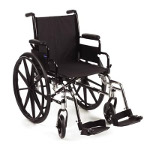 Manual wheelchairs are usually the least expensive type of wheelchair, although there are a number of different models and some of the more specialized ones are quite pricey.
Manual wheelchairs are usually the least expensive type of wheelchair, although there are a number of different models and some of the more specialized ones are quite pricey.
The manual wheelchair design dates back to a wheelchair first developed during the first part of the twentieth century. They feature a hollow steel tube frame, which provides strength, while still being lightweight, as well as large side wheels.
Typically, the wheels are designed so that they can be used to propel the wheelchair and include handrails that extend around the rim of the wheel. However, this is not always the case, as some manual wheelchairs, most often referred to as transport chairs, are designed to be pushed from behind. These chairs are often used by caregivers for seniors who have arthritis, as they are unable to propel the wheelchair on their own.
In addition to offering a lightweight frame, the steel tube design usually also allow the wheelchair to be folded up. The type of seat present will often determine if the wheelchair is intended to be a folding manual wheelchair or a rigid one, as those with a thin vinyl seat can almost always be folded, while those with a more rigid cushion seat are sometimes designed to be non-folding. However, a non-folding manual wheelchair is the exception and not the rule.
In addition to the standard wheelchairs most people have come to expect to see at places like the hospital or amusement parks, a number of more advanced sports wheelchairs are also available, which are used to do things like play wheelchair basketball or racing.
Electric Wheelchairs
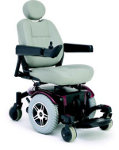 Electric wheelchairs are usually much more expensive than a standard self-propelled wheelchair and come in a number of designs and styles. The needs of the patient often plays a factor in what type of wheelchair is needed, which can affect the cost.
Electric wheelchairs are usually much more expensive than a standard self-propelled wheelchair and come in a number of designs and styles. The needs of the patient often plays a factor in what type of wheelchair is needed, which can affect the cost.
While there are a number of different styles available, most share a similar design, with a plastic base, which houses the electric motor and wheel-base, with a chair on top. Unlike manual wheelchairs, in most cases the chair closely resembles an office chair, although typically with more cushion and a higher back.
The wheel-base is either four wheels or six-wheels, which is the design used in a mid-wheel drive wheelchair system. The advantage of a mid-wheel design is that it provides much more maneuverability, at the sacrifice of a little stability. The drive wheels are the middle set, while the sets at the front and back merely provide support for the user.
The wheelchair itself is controlled by a hand control, which is usually found in the arm-rest of the chair. Most utilize a joystick control, which is based off on of the earliest electric wheelchair designs that dates back over 50 years. However, for those who are unable to use their hands, a number of alternative control devices are available, like breath operated wheelchairs, in addition to available controls for care workers.
What Type of Wheelchair is Best for Me?
Monday, August 9th, 2010
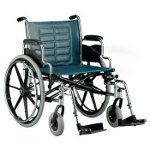 A wheelchair is probably one of the most recognized types of home medical equipment and dates back much further than other types of medical equipment. However, even though the history of the wheelchair, can be traced back many thousands of years, the modern wheelchair has roots that are much much younger.
A wheelchair is probably one of the most recognized types of home medical equipment and dates back much further than other types of medical equipment. However, even though the history of the wheelchair, can be traced back many thousands of years, the modern wheelchair has roots that are much much younger.
Manual Wheelchairs
Today, most manual wheelchairs feature a folding frame that is made out of lightweight hollow metal tubes. The seat has traditionally been made out of vinyl that is sewn around the wheelchair frame, although many newer wheelchairs incorporate improved padding and support. To allow the wheelchair user to self-propel, a manual wheelchair has large real wheels with metal hand-rims attached to the outside of the wheel.
The handrims allow the user to spin the wheels freely and easily, without making contact with the part of the tire that actually touches the ground. The front wheels are much smaller and are on pivots that allow the wheelchair to be turned simply by pushing it in a certain direction or by applying more pressure to one of the handrims.
These modern manual wheelchairs vary slightly in features, with some offering things like adjustable axles or different types of front rigging, which is the place at the front of the wheelchair where the user places their foot. However, the basic design is based on the Everest and Jenning’s Wheelchair(E&J Wheelchair) that was developed during the 1930′s. At this time, most wheelchairs where made out of a combination of wood and wicker, making them extraordinarily difficult to transport and also very hard to self-propel. Two inventors, named Everest and Jenning, set out to build a wheelchair that could be easily moved from place to place and also used without the help of a caretaker, creating a wheelchair frame whose influence can still be seen today in virtually all types of manual wheelchairs.
The manual wheelchair remains the most common type of wheelchair, with many people now opting to use a sports wheelchair, which is typically smaller and offers a number of performance improvements, but electric wheelchairs are also quite popular. Electric wheelchairs are much more expensive than manual wheelchairs, but since the device is powered by an electric motor, it requires little effort on the part of the user, aside from pushing the hand control in the desired direction.
Electric Wheelchairs and Power Chairs
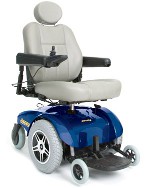 Electric wheelchairs come in a number of different shapes and sizes, as well as offering a number of different control methods, but the joystick control remains the most common. The joystick is mounted to one of the armrests of the wheelchair, allowing for either left hand or right hand use, with the wheelchair users simply pushing the joystick in the direction they wish to travel. For people with limited upper-body strength, a manual wheelchair is often too difficult to use, requiring a great deal of effort, which is the reason many people opt for an electric wheelchair, or power chair.
Electric wheelchairs come in a number of different shapes and sizes, as well as offering a number of different control methods, but the joystick control remains the most common. The joystick is mounted to one of the armrests of the wheelchair, allowing for either left hand or right hand use, with the wheelchair users simply pushing the joystick in the direction they wish to travel. For people with limited upper-body strength, a manual wheelchair is often too difficult to use, requiring a great deal of effort, which is the reason many people opt for an electric wheelchair, or power chair.
For those who are unable to use the joystick control, a number of alternate wheelchair controls are also available. One of the earliest alternate controls, which was first developed around the same time as the first electric wheelchair during the 1950′s, relies on head movements to steer the wheelchair. There are also remote controls available for caretakers, as well as a variety of much more advanced systems, including those that allow the power chair to be controlled by the breath of the user.
Wheelchairs continue to be one of the most common and well known types of home medical equipment, offering a way of improving accessibility. While power chairs are very convenient and easy to use, they tend to cost a lot more than manual wheelchairs, which can typically be found both new and used for at least a thousand dollars less than a power chair.
The Development of the Modern Wheelchair
Monday, January 25th, 2010
 The wheelchair is one of the oldest types of home medical equipment, dating back thousands of years, with images depicting the use of carts and similar devices, used to transport those with limited mobility. However, if you looked at most of the early wheelchairs, you might not even recognize them as a wheelchair, nor where they something that was generally available to the regular population.
The wheelchair is one of the oldest types of home medical equipment, dating back thousands of years, with images depicting the use of carts and similar devices, used to transport those with limited mobility. However, if you looked at most of the early wheelchairs, you might not even recognize them as a wheelchair, nor where they something that was generally available to the regular population.
In the past, wheelchairs were traditionally only available to those such as nobility or who had the means to have one constructed. This is because there was no set standard to them, so instead the wheelchair had to basically be reinvented each time it was built, relying on the skills of the builder.
Towards the end of the nineteenth century, this began to change, with a semi-standard wicker wheelchair becoming much more common. This was in part due to the increased number of war veterans from the Civil War. These early wheelchairs where relatively inexpensive and featured a large wicker chair, which was often very high backed. Sometimes, however, wood was used in place of wicker, which was much sturdier, but also a great deal heavier.
While a big step up from the older models of wheelchairs, the wicker and wood wheelchairs were very cumbersome and could rarely be transported easily. They also usually required someone to push the wheelchairs, leaving the wheelchair user dependent on friends, nurses, or other caregivers to get around. These wheelchairs would remain common until the early 1930′s, when a much lighter wheelchair was developed.
The improved wheelchair, which was developed during the 1930′s was referred to as the E&J wheelchair, named for its inventors Everest and Jennings. What sets this apart from other wheelchairs was that it had a solid metal frame, constructed using hollow steel tubes. This provided a great deal of strength, but because the metal was hollow, it was not very heavy. The E&J wheelchair could also be folded up, making it much easier to transport in carriages and the less common automobile. In addition, the wheelchair featured large front wheels, allowing the wheelchair user to self propel, without the need to rely on a caretaker.
As was the case with the previous wheelchair design, much of the innovation and adoption was the result of injured veterans, this time from World War I. A few years later, World War II would begin and the E&J wheelchair would become the default wheelchair design.
By the 1950′s, the E&J wheelchair was still the most common choice of wheelchair, with inventors creating a electric wheelchair kit that could be used to convert a regular manual wheelchair to an electric one. These kits became very popular, with companies from Canada and New York developing quick converter kits.
Today, the E&J wheelchair design is still seen in most manual wheelchairs, with its lightweight hollow metal frame and folding design, making it a great choice for traveling. In fact, Everest and Jenning wheelchairs are still available, as the company has remained a powerful name in the wheelchair industry.
Manual Wheelchairs vs Electric Wheelchairs: A Buyers Guide
Monday, January 4th, 2010
Wheelchairs are important safety tools that are used by those who are unable to walk or have difficulty doing so. While the wheelchair has roots that date back thousands of years, modern wheelchairs are based off of a hollow steel tube design that was developed during the 1930′s. This design remains popular today and helps keep the weight of the wheelchair down, without sacrificing its strength.
While the folding steel tube manual wheelchair is still very common, many wheelchair users prefer electric wheelchairs. Electric wheelchairs offer the same basic functionality that manual wheelchairs offer, except they are operated electronically. Electric wheelchairs also have a design that is much different than a manual wheelchair is.
How Manual Wheelchairs are Designed
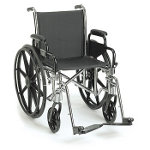 A manual wheelchair usually has a wide chair, with two large wheels on either side and two small wheels in front. The larger wheels have handrails that extend off of the wheel and allow the user to move the wheels, without having to actually touch that part f the wheel that makes contact with the ground.
A manual wheelchair usually has a wide chair, with two large wheels on either side and two small wheels in front. The larger wheels have handrails that extend off of the wheel and allow the user to move the wheels, without having to actually touch that part f the wheel that makes contact with the ground.
Many manual wheelchairs also have push handles that extend backwards from the top of the chairs seat, allowing someone to push the wheelchair from behind.
While most manual wheelchairs are designed to be self-propelled, which is why they have the larger rear wheels, some wheelchairs are only designed to be pushed. These wheelchairs, which are sometimes called transfer wheelchairs or transport wheelchairs, have much smaller wheels.
Sports wheelchairs are also very popular and come in a variety of designs. Some, like those used during wheelchair basketball or wheelchair rugby, are very specialized. For example, since wheelchair basketball can be so dangerous, a wheelchair basketball sports wheelchair will have a guard around the entire wheelchair. Another example of a specialized sports wheelchair is those used for wheelchair racing, which have a much longer wheelbase than other wheelchairs.
Other sports wheelchairs offer a much less specialized design, with a focus more on being lightweight and small, while allowing for optimal turning and speed. These are a popular choice by many wheelchair users, even those who do not actually play wheelchair sports.
How Electric Wheelchairs Are Designed?
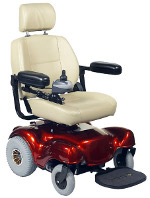 Electric Wheelchairs, on the other hand, are not intended to be self-propelled and are instead operated using a rechargeable battery. As a result, they only have a limited range before the battery must be recharged.
Electric Wheelchairs, on the other hand, are not intended to be self-propelled and are instead operated using a rechargeable battery. As a result, they only have a limited range before the battery must be recharged.
The weight of the rider as well as what type of terrain is driven over can affect the wheelchairs per-charge range. So, for example, driving up hill will wear the battery out quicker than driving it on level ground. With that said, many have ranges that are over 8 miles per charge, which is a fairly large distance for most people.
Unlike manual wheelchairs, the wheelbase of an electric wheelchair is very small. Some have four small wheels, with the rear wheels being responsible for actually moving the wheelchair. Other power chairs use a mid-wheel drive system, with a set of wheels in the front and back that provide support, while the set of wheels in the middle are responsible for moving the chair. Usually a mid-wheel drive power chair is much more maneuverable than a rear-wheel drive power chair.
Atop of the plastic base of the power chair, a captains chair is installed. Usually the captains chair is designed similarly to an office chair. The armrests can be folded up and the actual control system is placed on either the right or left armrest. The chair can also be pivoted to make it easier to enter and exit the wheelchair.
Like office chairs, the style of the captains chair varies depending on the model of the electric wheelchair. For instance, some will have a much higher back with head and neck support, while others have a considerably lower back without any neck support.
What is Best For Me?
Often, choosing between a power chair or a manual wheelchair comes down to personal preference. For instance, many prefer the physical effort that is required to use a manual wheelchair, while others find that it is too strenuous.
Cost is also a factor, as you can usually find a quality manual wheelchair for less than $500, while an electric wheelchair usually starts at $1500 and goes up from there.
It is also important to consider where you will be using the wheelchair, as if you are only planning on using it around the home, an electric wheelchair could be overkill. On the other hand, someone going to school and traveling across campus daily might prefer an electric wheelchair.
Transporting the wheelchair is another concern. Most manual wheelchairs are designed to be folded when not in use. This allows them to be stored in the trunk of a car or even the backseat with little difficulty. Electric wheelchairs, on the other hand, are considerably heavier and will often require some sort of wheelchair lift is installed onto the automobile.
Another consideration is that a Manual Wheelchair will almost always work, providing it is regularly maintenance. An electric wheelchair is more prone to mechanical or electrical failure, as well as being more sensitive to rain and other elements. As a result, a manual wheelchair often provides a much more long term and dependable option, without the need for replacing batteries or other maintenance that is required on a power chair.
The History of the Modern Wheelchair
Saturday, November 14th, 2009
Wheelchairs have become one of the most common types of mobility vehicles and are used by people in every country in the World. However, unlike many other types of inventions, the wheelchair is relatively new and the modern wheelchair is actually less than 100 years old.
When the history of the wheelchair is considered, records can be traced back thousands of years that describe devices that were used by people who were unable to or had difficulty walking. These early devices are classified as wheelchairs, but when you consider their design and the way they were used, they are incredibly different from the modern wheelchair. In these early times, building and constructing a wheelchair was very expensive and often something that was only available to royalty.
It was also very common for early wheelchairs to work more as carts or even prams, in that the person using the wheelchair had to be pushed around by others. There were, of course, several early self propelled wheelchairs, but these often used hand cranks and were more of a novelty for kings, rather than a tool for the disabled.
Towards, the end of the nineteenth century and the early twentieth century, wheelchair design began to become more standardized, in part due to lessons learned during the civil war. It was during this time that the wicker wheelchair became very popular. These wheelchairs had two wheels on the side, with a third wheel in back for support. The wheelchair itself was mostly made out of wicker, which is a made of weaving fiber together to form a strong rigid material.
The wicker wheelchairs had a very long back and were rather cumbersome. Even though they often had larger wheels on the sides, it was seldom easy or even possible to self-propel with this type of wheelchairs. Also, due to their large size, transporting a wicker wheelchair was simply not something that could be done easily or without expending abnormal resources.
Still, the design of the wicker wheelchair worked very well and hospitals all over the country adopted this design. Some people would also construct wooden wheelchairs, using a similar design to the wicker chair, only using boards of wood instead of wicker.
Wicker wheelchairs would remain popular for about twenty years, up until the mid-thirties, when a new type of wheelchair was developed. It was at this time when the E&J wheelchair was developed, which would revolutionize wheelchair design. The E & J wheelchair was designed by two inventors named Everest and Jennings.
Herbert Everest was an engineer who had suffered a back injury and was confined to a wheelchair. Together with Jennings, another Engineer, Everest set out to address several issues that made using a wheelchair in the 1930′s very difficult. Specifically they developed a folding lightweight wheelchair, which could be easily traveled with.
The E&J wheelchair used hollow metal tubes to provide excellent strength and support, without adding too much weight. It also featured large wheels on the side, which could be self propelled, by the user. Today, this design is still used and its influence can be seen in almost all manual wheelchairs.
Selecting the Right Type of Wheelchair
Monday, November 9th, 2009
 For the wheelchair user, choosing between an electric wheelchair and a manual one is often the first and hardest decision when it comes to selecting a mobility vehicle. Selecting the right wheelchair does not need to be difficult, however, and by determining your needs, the process can be made much simpler.
For the wheelchair user, choosing between an electric wheelchair and a manual one is often the first and hardest decision when it comes to selecting a mobility vehicle. Selecting the right wheelchair does not need to be difficult, however, and by determining your needs, the process can be made much simpler.
Considering the Cost of Electric and Manual Wheelchairs
One of the first factors for many trying to decide between a manual wheelchair and an electric wheelchair is price. Electric wheelchairs usually cost considerably more than manual wheelchairs.
Usually an electric wheelchair, or Power Chair, will cost between $1300 and $5000. The lower priced models usually come from lesser known wheelchair manufacturers, such as ShopRider, and the more expensive wheelchairs coming from manufacturers like Pride Mobility and Golden Technologies. While ShopRider Electric Wheelchairs are much less expensive, they do not have the same reputation as Golden Electric Wheelchairs and Pride Electric Wheelchairs.
Manual Wheelchairs usually cost much less, often around $500 and rarely over $1000. The exception to this is sports wheelchairs, which can sometimes cost just as much as electric wheelchairs. Sports wheelchairs are designed to be lightweight and durable, in addition being designed for specific types of wheelchair sports.
Considering the Wheelchair User’s Needs and Abilities
Another consideration when trying to decide whether to go with a power chair or a manual wheelchair is the abilities of the wheelchair user and how the wheelchair will be used. Depending on the users ability, using a manual wheelchair may not be an option, as they require a great deal of upper body strength. Even people who are in excellent shape find that a manual wheelchair can be very strenuous.
In regards to how the wheelchair will be used, it is important to spend some time thinking about what places you are likely to take the wheelchair. If it is just going to be used in the home most of the time, having an electric wheelchair may very well be unnecessary.
However, those who plan on using their wheelchair to travel across more than a mile or two each day, such as a college student, may find that an electric wheelchair is a much better choice. This is because most electric wheelchairs, even the lower end models, can travel more than 5 miles on a charge, with most having a range between 10 and 20 miles per charge.
Transporting the Wheelchair
Considerations on transporting the wheelchair should be thought about before actually purchasing a wheelchair, because it is a very important factor. In some regards it ties into the above topic of where the wheelchair will be used.
Typically, transporting a manual wheelchair is very easy, as they are designed to be folded up and are lightweight enough that they can easily be lifted into the back seat of a car or the trunk area. This makes using a manual wheelchair away from home very easy.
Electric wheelchairs are not as easy to transport and usually require that some sort of wheelchair lift be installed on the vehicle. This adds to the total cost of ownership of an electric wheelchair, but vehicle wheelchair lifts are very convenient and easy to use.
Selecting the right type of wheelchair need not be difficult, but it is also not a decision that should be taken lightly. It is essential to take into account the user and their needs, as well as other factors, such as cost and ease of transportation.
Self-Propelled Wheelchairs and Power Chairs
Monday, October 12th, 2009
Over the history of mankind, there have always been inventions that are designed to help those who can not walk. In the grand scheme of things these devices are considered to be wheelchairs, but they are not usually what most people think of as a wheelchair. Instead, the hollow tubbed metal frame with its vinyl seats that most people first think of when considering a wheelchair is a new invention that has been around for less than 100 years.
Today, there are countless models and brands of wheelchairs, enough that it can almost be overwhelming when trying to shop for a wheelchair, but they all share a very similar design. This is not only true of most manual wheelchairs, but also electric wheelchairs.
Basic Manual Wheelchair Design
Most self-propelled manual wheelchairs have two rear wheels that are larger in size. The rear wheels have another smaller rim attached to the outside of the wheel, which allows the user to spin the wheel, without having to actually touch that parts that makes contact with the ground.
Most manual wheelchairs also have a set of push handles attached to the frame of the wheelchair, which allow it to be pushed easily. Transfer wheelchairs, which are not designed to be self-propelled, do not usually have handrims on the rear wheel and instead the rear wheels are only slightly larger than the front wheels.
The Folding Wheelchair Frame
The typical manual wheelchair is also designed to be folded when not in use, which allows it to be placed in the rear of a car without the need of a vehicle wheelchair use. This also makes them well suited for traveling. The frame of the wheelchair is made out of hollow tubes of metal, with steel being the most common type, which is very sturdy and lightweight. Other metals are also sometimes used, but they tend to be more expensive, with the main advantage of these alternate metals being their lightweight. Many sports wheelchairs will make use of a non-steel metal.
Differences Between Manual and Electric Wheelchairs
While electric wheelchairs no longer use a design that is very similar to a manual wheelchair, they do all standard design. Most consist of a small plastic base, which houses the electric motor, rechargeable batteries, axles, and other electrical components. The chair is attached to the base of the wheelchair and armrest controls are usually attached, using a simple joystick control scheme. This allows the wheelchair to be controlled by simply pushing the joystick in the desired direction. The joystick can be configured for either right hand or left hand use, by simply changing which side of the armrest it is attached to.
Of course, there are a number of people who can not use the standard wheelchair control, so there are a number of alternative wheelchair controls available. This includes wheelchairs that are controlled by head movements, the users breath, and even by remote control.
In the case of electric wheelchairs, they can usually travel between 4 and 8 miles per charge, although this is something that varies depending on the weight of the user and the type of terrain the wheelchair is driven over. For instance, driving an electric wheelchair up a hill repeatedly will wear it down faster than if it were driven across flat ground.
Choosing Between a Manual Wheelchair and a Power Chair
Tuesday, September 15th, 2009
In today’s world, the choice of manual or electric often gets looked upon as an easy choice, with power almost always getting looked upon as the easier and more efficient solution. This can be seen in most peoples choice of power tools, power windows, and power steering. However, in the world of manual and electric wheelchairs, the choice is not so straightforward or easy, as both have advantages and disadvantages.
A Look Back at the History of the Wheelchair
Wheelchairs have been used for thousands of years, with images being found that indicate ancient Asians were among some of the first to make use of a wheelchair for those who had difficulty walking. During the middle ages, wheelchairs would be relatively common, but because they had to be custom made, they were almost only available to those who had the resources to build them, such as figures of nobility.
It would not be until much later during the early nineteenth century that wheelchairs would take on a more standard design, using a simple foldable lightweight steel tube frame. Today, this same design remains incredibly popular among manual wheelchairs and electric wheelchairs are also very common, with an electric motor concealed in a base made of molded plastic and a seat attached to the base of the wheelchair.
Choosing the Right Wheelchair: The User
One of the first , and arguably most important, steps in deciding whether to use a manual wheelchair or an electric wheelchair revolves around the physical abilities of the wheelchair user. It takes a great deal of physical effort to use a manual wheelchair and this can put a great deal of stress on the upper-body. As a result, using a manual wheelchair can be very strenuous, too much so for many
There is of course also something to be said for personal preference, as many people enjoy using a manual wheelchair precisely because it requires more physical effort. There are a number of sports, such as wheelchair basketball, wheelchair tennis, and wheelchair racing, which make extensive use of manual wheelchairs as well and many wheelchair users prefer the feeling of independence and flexibility that is offered by using a manual wheelchair. .
Choosing the Right Wheelchair: The Location
While the physical condition of the wheelchair user is one of the most important considerations, the location where the wheelchair will be used is also important. For example, if the wheelchair is primarily going to be used around home, then it will require much less upper-body strength to use than if it were to be used around a college campus. As a result, for home use, many people prefer the simple and less complicated design of a manual wheelchair.
However, those that will be using the wheelchair across larger distances, such as around town or driving around the neighborhood, might be better served with an electric wheelchair.
Choosing the Right Wheelchair: The Cost
One of the other major considerations when choosing between an electric wheelchair or a manual wheelchair is the cost of the device. While it is possible to spend a great deal on a manual wheelchair, they still typically cost a great deal less than an electric wheelchair. For those who are unable to get a Medicare wheelchair, Medicaid Wheelchair, or other insurance discount, an electric wheelchair might simply not be affordable.
A Look at Wheelchair Development
Friday, September 11th, 2009
Mobility vehicles of some shape or form have been around for hundreds and thousands of years. These devices are important tools for increasing accessibility and allowing those who have difficulty walking to get around.
Early Wheelchair Design
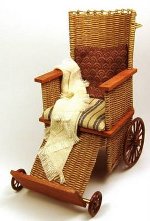 In the early days, there was no standard to these devices and often they were only affordable by nobility. It was also not uncommon for the kings and other royalty who used these early wheelchairs to need them more as a result of their lavish lifestyle, rather than out of a practical need.
In the early days, there was no standard to these devices and often they were only affordable by nobility. It was also not uncommon for the kings and other royalty who used these early wheelchairs to need them more as a result of their lavish lifestyle, rather than out of a practical need.
This began to change towards the end of the nineteenth century, when a wicker wheelchair was designed. The wicker wheelchair had a very high back and sides, with two wheels on the side and one in the back. Due to its large size and the design of its wheels, it was very hard for a wheelchair user to self propel this type of wheelchair or even to transport it away from the hospital. Still, it was much more effective than previous designs and was adopted across the United States by most hospitals.
The Development of the Folding Self-Propelled Wheelchair
 The wicker wheelchair had a number of design problems that made it very difficult for the average wheelchair user to use. As a result, two inventors, one of whom was in a wheelchair, worked together to develop a lightweight foldable wheelchair. Their design, which is known as the E & J wheelchair, made use of a frame made out of hollow steel tubes, which provided a great deal of support and strength, but without the same weight as that of a wicker wheelchair. The steel tube frame could also be folded up, making the wheelchair much easier to transport.
The wicker wheelchair had a number of design problems that made it very difficult for the average wheelchair user to use. As a result, two inventors, one of whom was in a wheelchair, worked together to develop a lightweight foldable wheelchair. Their design, which is known as the E & J wheelchair, made use of a frame made out of hollow steel tubes, which provided a great deal of support and strength, but without the same weight as that of a wicker wheelchair. The steel tube frame could also be folded up, making the wheelchair much easier to transport.
At the time the E & J wheelchair was invented, America was on the precipice of the Second World War and so the wheelchair was put to great use. The development of antibiotics meant that soldiers were able to recover from wounds that even only a few short years ago would have been fatal, with many soldiers returning from the war without full use of their legs.
The E & J wheelchair would remain the standard for some time and the first electric wheelchairs were built around its frame. A number of companies began to sell converter kits that allowed the E & J wheelchair to be inexpensively converted to an Electric Wheelchair. These made use of a simple electric motor that could be attached to the axle of the wheelchair and controlled by a simple joystick placed on the wheelchair’s arm. While the design of a modern electric wheelchair is much different, the joystick control scheme is the standard for most electric wheelchairs. However, there are also a number of other control systems available for those who can not use a joystick.
Today, the basic design of the E & J wheelchair has remained the same and can be seen in most modern manual wheelchairs, although there are many other popular wheelchair manufacturers.
Manual or Electric, Not Just a Question for Tim Taylor
Wednesday, September 9th, 2009
For those wheelchairs, often one of the most important decisions is whether to choose a manual wheelchair or an electric wheelchair. There are a number of factors that go into this decision and it is important to spend some time considering what type of wheelchair will best fit the needs of the wheelchair user.
A Brief Look at the Development and History of the Wheelchair
Wheelchairs have been around for thousands of years, albeit in a much less standard design than what we are used to today. Early wheelchairs were often custom made and during the middle ages, they were often a byproduct of the gratuitous lifestyle of nobility, who were able to afford to have a smith custom build a wheelchair. As time went on, several designs would come and go. Prior to the metal tubed lightweight foldable wheelchair common today, a wicker wheelchair became popular. These had a very high back and three wheels, with two on either side and one in back for support. While these kinds of wheelchairs were very popular and common during the turn of the twentieth century and even up until the 1940′s, the wicker wheelchair left a lot to be desired, because it could not be easily self propelled.
Today, a great deal of thought and design has gone into the manual wheelchair, making it very efficient and lightweight. Electric wheelchairs are also very common and include an electric motor and rechargeable battery to quickly and easily move an individual across many types of terrain.
Choosing the Right Wheelchair
Choosing between an electric wheelchair and manual wheelchair should not be a decision that is taken lightly and there are in fact a number of things that must be taken into consideration.
The Abilities of the Wheelchair User
One of the most important things to consider when deciding between a manual wheelchair or an electric wheelchair is how well an individual will be able to use a manual wheelchair.
Due to disease, illness, or injury, it may not be possible to use a manual wheelchair, because using a manual wheelchair can be very strenuous. As a result, in many cases, due to the physical abilities or the wheelchair user, using a manual wheelchair may simply be out of the equation. In these cases an electric wheelchair may be a better choice and there are a number of alternate control systems available that make using a wheelchair much easier, such as allowing the user to control it with head.
However, many people enjoy manual wheelchairs for just this reason and enjoy the physical effort required to use it. There are many wheelchair sports that are becoming increasingly popular, such as wheelchair racing and wheelchair rugby. So, for a number of wheelchair users, the physical effort required to use a manual wheelchair is looked on as a benefit. Manual wheelchairs are also much more responsive, in that the wheelchair user ultimately has a great deal more control over the wheelchair, which is a big benefit for many, just as many people prefer manual vehicles over automatics.
Where the Wheelchair Will Be Used
The place and location that the wheelchair will primarily be used is also an important thing to think about. If the wheelchair is going to be primarily used in the home, then using a manual wheelchair will require a great deal less effort than if it were to be a mode of transportation across a college campus. If on the other hand, the wheelchair will be used away from home, an electric wheelchair, which often has a per-charge range of over 15 miles, might be a much more efficient and practical choice.
Determining how and where the wheelchair will be used is important. It is also important to consider how the wheelchair will be transported though, because a manual wheelchair can be folded up and placed in the back seat of a car or the trunk with little problem. Transporting an electric wheelchair is not usually as easy and typically requires a vehicle wheelchair lift.
The Cost of the Wheelchair and Wheelchair Accessories
As is usually the case, it is also important to consider cost when deciding whether to use a manual wheelchair or an electric wheelchair. If it is possible to get a Medicaid Wheelchair or a Medicare wheelchair, then the cost of the wheelchair will be greatly reduced, with the insured usually only responsible for 20% of the cost.
However, if insurance is not an option, than an electric wheelchair can be very expensive, at least in comparison to a manual wheelchair. Even a top end manual wheelchair is usually much less expensive than a power chair, so it is important to consider your budget.
When considering cost, it is also important to consider operating cost, as a power chair will require periodic replacement batteries, usually once every 12 to 18 months, depending on use. Power chairs also usually require a vehicle wheelchair lift to make transportation easier, so if it will be used away from home, this could be an additional cost. It may also be necessary to install a wheelchair lift or a wheelchair ramp at home, which in reality is probably needed for both power chairs and manual wheelchairs, although it is most assuredly needed to move a power chair into and out of the house, as electric wheelchairs are much heavier than manual wheelchairs.